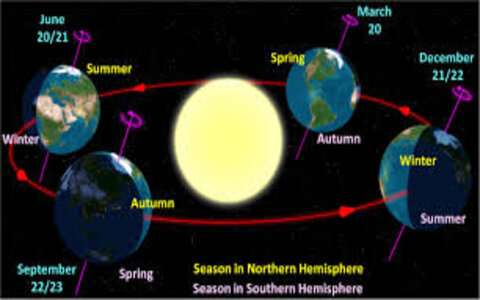We experience different seasons throughout the year. In South Africa, we have four seasons: autumn from March to May, winter from June to August, spring from September to November and summer from December to February. But what is the reason for these seasonal changes?
Many people think it is summer in some parts of the world when Earth is nearer to the sun. And, similarly, they think when Earth is farther away from the sun it is winter. This is incorrect.
Why do we have seasons?
Earth rotates around its axis, an imaginary straight line that runs through the North and South Poles, making a complete turn each day. This is why we have day and night. We experience different seasons because Earth’s axis is tilted at an angle of 23.5 degrees. The axis does not stand up straight.
Earth spins on its axis as it orbits the sun but the North Pole always points in the same direction. This means that the Northern Hemisphere leans towards the sun for half of the year and away from the sun for half of the year. The Northern Hemisphere is made up of half of Earth that is north of the equator. USA and India are examples of countries in the Northern Hemisphere.
Correspondingly, the Southern Hemisphere leans towards the sun half for the year and away for the other half. The Southern Hemisphere is made up of half of Earth that is south of the equator. South Africa and Zambia are examples of countries in the Southern Hemisphere.

Therefore, when it is summer in India (a country in the Northern Hemisphere), it is winter in South Africa (a country in the Southern Hemisphere). Autumn and spring take place in between these seasons.
Characteristics of each season
The position of the sun in the sky differs with the seasons. The sun is at its highest in summer; higher than in the other three seasons. The sun reaches its maximum height at 12pm on any given day.
In summer, temperatures may increase to their hottest of the year. The long hours of daylight in summer allow Earth plenty of time to reach warm temperatures. The sun is higher in the sky and its rays strike Earth at a steep angle.
In autumn, temperatures decrease. The North Pole starts to move away from the sun. The days get shorter as the sun’s maximum height gets lower. We reach the autumn equinox around 22 September every year when the sun is at its mid-point in the sky. The autumn Equinox is the first day of the autumn season. The day and night are both 12 hours long.
In winter, some parts of Earth may experience snow or ice, while others see only cold rain. The sun is lower in the sky and as a result the rays of the sun strike Earth at a shallow angle. The longer nights and shorter days allow Earth less time to warm up.
In spring, the weather is warmer and usually wet. The North Pole starts leaning toward the sun. The height of the sun in the sky increases and the days begin getting longer again. We reach the spring equinox around 21 March every year when the sun is at its mid-point in the sky. The spring equinox is when the day and night are both 12 hours long.
In a nutshell, we experience different seasons throughout the year because Earth is tilted. So, if you are in the Southern Hemisphere and you want to visit a country in the Northern Hemisphere in June, bring your shorts and sandals instead of knitwear!
Tell us: Tell us: What is your favourite season and why?

